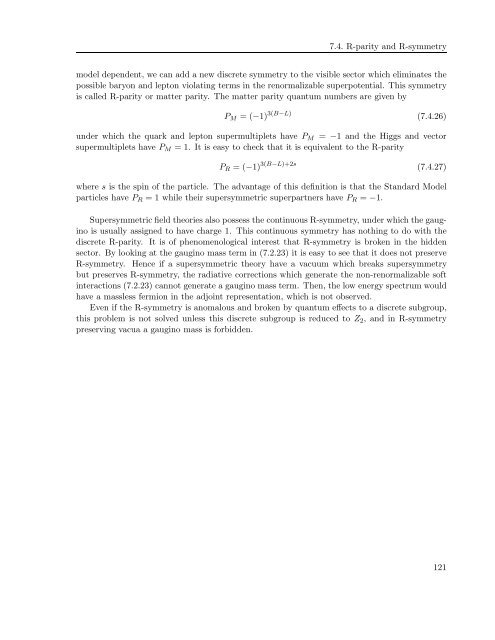Perturbative and non-perturbative infrared behavior of ...
Perturbative and non-perturbative infrared behavior of ...
Perturbative and non-perturbative infrared behavior of ...
You also want an ePaper? Increase the reach of your titles
YUMPU automatically turns print PDFs into web optimized ePapers that Google loves.
7.4. R-parity <strong>and</strong> R-symmetry<br />
model dependent, we can add a new discrete symmetry to the visible sector which eliminates the<br />
possible baryon <strong>and</strong> lepton violating terms in the renormalizable superpotential. This symmetry<br />
is called R-parity or matter parity. The matter parity quantum numbers are given by<br />
PM = (−1) 3(B−L)<br />
(7.4.26)<br />
under which the quark <strong>and</strong> lepton supermultiplets have PM = −1 <strong>and</strong> the Higgs <strong>and</strong> vector<br />
supermultiplets have PM = 1. It is easy to check that it is equivalent to the R-parity<br />
PR = (−1) 3(B−L)+2s<br />
(7.4.27)<br />
where s is the spin <strong>of</strong> the particle. The advantage <strong>of</strong> this definition is that the St<strong>and</strong>ard Model<br />
particles have PR = 1 while their supersymmetric superpartners have PR = −1.<br />
Supersymmetric field theories also possess the continuous R-symmetry, under which the gaugino<br />
is usually assigned to have charge 1. This continuous symmetry has nothing to do with the<br />
discrete R-parity. It is <strong>of</strong> phenomenological interest that R-symmetry is broken in the hidden<br />
sector. By looking at the gaugino mass term in (7.2.23) it is easy to see that it does not preserve<br />
R-symmetry. Hence if a supersymmetric theory have a vacuum which breaks supersymmetry<br />
but preserves R-symmetry, the radiative corrections which generate the <strong>non</strong>-renormalizable s<strong>of</strong>t<br />
interactions (7.2.23) cannot generate a gaugino mass term. Then, the low energy spectrum would<br />
have a massless fermion in the adjoint representation, which is not observed.<br />
Even if the R-symmetry is anomalous <strong>and</strong> broken by quantum effects to a discrete subgroup,<br />
this problem is not solved unless this discrete subgroup is reduced to Z2, <strong>and</strong> in R-symmetry<br />
preserving vacua a gaugino mass is forbidden.<br />
121
















